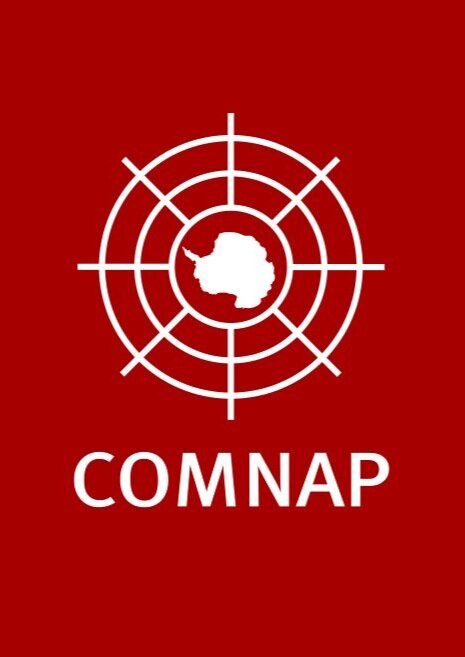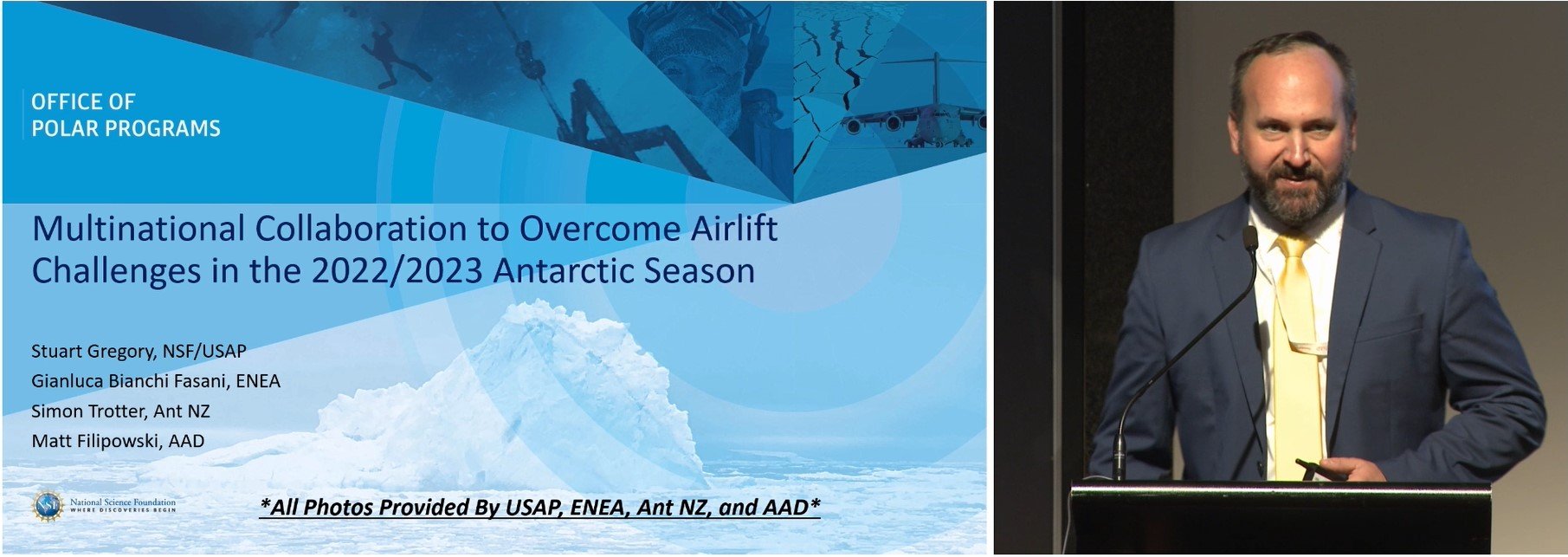
20th COMNAP Symposium (2023)
“Antarctic Innovations and Collaborations”
The 20th COMNAP Symposium (2023) “Antarctic Innovations and Collaborations” includes presentations covering, exploring and answering the following questions:
What were the key innovations of the past 60 years in Antarctica?
Which collaborations succeeded and what was the recipe for their success?
How can we use these to advance research operations from Antarctica for the next 100 years and how can we apply our knowledge to understand the importance of the Antarctic region to all of humanity.
How can COMNAP as an organization and COMNAP Member programs learn from our past experiences and achievements and how do we improve to meet, and excel beyond, our common goals?
Topical Innovation sessions include six subjects and themes:
a) Antarctic Roadmap Challenges (ARC) Outcomes
b) Building and Energy Efficiencies
c) Communications and data
d) Marine Platforms and Vessels
e) Safety
f) Telemedicine
Topical Collaboration sessions include six subjects and themes:
g) Air Network
h) COVID-19 Preparedness and response
i) Education, Outreach and Training
j) Environmental
k) Science and Science Facilitation
l) Search and Rescue
Keynote Speakers
-

Tim Heitland
Medical officer of the Alfred Wegener Institute, Germany
-

Deneb Karentz
Professor at USF and SCAR Vice President for Science
Oral in-person presentations
Transforming Antarctic Operations - management of change and modernisation of operations at BAS
Amie Jackson
British Antarctic Survey, United Kingdom
An Introduction to the research on Co-operative mobile Robot System Technology for Polar Region Development and Exploration
Dong-Jing Yoon
Korea Polar Research Institute, Republic of Korea
Concordia solar array and solar energy potential on Dome C site
Emilie Perrott
French Polar Institute Paul-Emile Victor (IPEV), France
The Energetic Modernisation of Neumayer Station III
Uwe Nixdorf
Alfred Wegener Institute (AWI), Germany
Energy Efficiency: New Antarctic scientific stations projects
Marcelo Leppe
Instituto Antártico Chileno (INACH), Chile
Innovation developments in JARE activities by NIPR for its 50 years commitments
Takuji Nakamura
National Institute of Polar Research (NIPR), Japan
Safety in Ship-based Polar Expeditions: An example of Turkish Polar Program
Doğaç Baybars Isiler
Turkish Polar Program, Türkiye
Multinational Collaboration to Overcome Airlift Challenges in the 22/23 Season
Stuart Gregory
United States Antarctic Program (USAP), United States of America
Snow runway for Ilyushin heavy aircraft in the Larsemann Hills (East Antarctica): renovation, statistics for the first season and future prospects
Svetlana Grigoreva
Russian Antarctic Expedition, Russia
Air operations in the polar depths; public-private cooperation and the use of natural blue ice runways
Miguel Figueroa
Fuerza Aérea de Chile, Chile
Logistical challenges on future upgrades of Syowa Station
Gen Hashida
National Institute of Polar Research (NIPR), Japan
Argentina and Australia collaboration on environmental biotechnology
Tim Spedding
Australian Antarctic Division (AAD), Australia
Success Through International Collaboration in Microgrid Operation on Ross Island
Maria Fernando
Antarctica New Zealand, New Zealand
The Swiss Polar Institute Antarctic Circumnavigation Expedition
Danièle Rod
Swiss Polar Institute, Switzerland
Team Polar – A sustainable & autonomous research rover for Antarctica
Laurenz Edelmann
Team Polar, Netherlands Polar Programme, Netherlands
Implementing an Antarctic Regional Climate Centre Network
Robert Argent
Bureau of Meteorology, Australia
Collaborative logistics to deliver operational efficiencies
Dave Wattam
British Antarctic Survey (BAS), United Kingdom
Lessons learned from past aerogeophysical collaborations for effectively launching new pan-Antarctic RINGS surveys
Kenichi Matsuoka
Norwegian Polar Institute (NPI), Norway
Balloon Ice caves in Antarctica
Rocco Ascione
Programma Nazionale di Ricerca in Antartide (PNRA), Italy
Spanish Antarctic Facilities “BAES”: A Scientific and Technical Infrastructure open to international collaboration
Sonia Ramos
Comité Polar Español (CPE), Spain
Oral on-demand video presentations
Enabling Science with a Subsea Fibre Optic Cable for McMurdo Station, Antarctica
Patrick Duncan Smith
United States Antarctic Program (USAP), United States of America
Ecuadorian Antarctic Refuge: The use of eco-materials, thermal conservation, and identity
Carlos Alberto Andrés Donoso Paulson
Universidad Catolica de Santiago de Guayaquil, Ecuador
Foraging niche divergence in a climate change sentinel from the Antarctic Peninsula: evidence from bulk and compound-specific stable isotope analysis
Renan Costa de Lima
COMNAP Antarctic Fellowship Awardee
Posters presentations
Decarbonising Antarctica Discussion Forum: An example of idea sharing to overcome a common challenge
Sophia White
Antarctica New Zealand, New Zealand
Energy Efficiency Considerations for McMurdo Station Lodging Facility
Ben Roth
United States Antarctic Program (USAP), United States of America
Antarctic Infrastructure Renewal Program: Drivers and Strategies
Matthew Wuersching
Australian Antarctic Division (AAD), Australia
Silver Arctic - A new platform for supply and research in the Southern Ocean
Stig Flått
Norwegian Polar Institute (NPI), Norway
Development of a Man-Portable Hybrid Autonomous Underwater Vehicle for Antarctic Deep Seabed Exploration
Arturo Cadena Torres
Ecuador
The USAP Antarctic Research Vessel (ARV) Project
Timothy M. McGovern
United States Antarctic Program (USAP), United States of America
Introduction of the RRS Sir David Attenborough – 2 years on
Richard Warren
British Antarctic Survey (BAS), United Kingdom
Using innovation to prevent Search and Rescue in the Australian Antarctic Program
Chris Gallagher
Australian Antarctic Division (AAD), Australia
Monitoring of natural hazardous objects of Antarctic oases: key results of the program implemented at the Larsemann Hills
Svetlana Grigoreva
Russian Antarctic Expedition, Russia
Expose to Treat – The Standardisation of Cold Casualty Care for Antarctica
Jonathon Lowe
British Antarctic Survey Medical Unit, United Kingdom
Leveraging the Pandemic: How Advancements in Technology and Telemedicine can Improve the Health and Well-being of the Antarctic Deployer
Elicia Liles
United States Antarctic Program (USAP), United States of America
Remote Medical Support to Polar Operations – The Effect of ‘Reach Back’ on Clinical Care Delivery
Jonathon Lowe
British Antarctic Survey Medical Unit, United Kingdom
DROMLAN (Dronning Maud Land Air Network) – 20 years of international collaboration - Establishing an efficient Air Network in Dronning Maud Land
Sven Lidström
Norwegian Polar Institute (NPI), Norway
Improving the Co-ordination of Antarctic Aviation Has Positive Safety Benefits
Rod Arnold
British Antarctic Survey (BAS), United Kingdom
Integrating RPAS into air operations
Carl Robinson
British Antarctic Survey (BAS), United Kingdom
Korea’s International Air Network Collaboration for the past 35 years
Mingu Kang
Korea Polar Research Institute (KOPRI), Republic of Korea
COVID-19 – A Review of the Impact of COVID-19 on Operations in the British Antarctic stations
Jonathon Lowe
British Antarctic Survey Medical Unit, United Kingdom
Covid 19 protocol in Punta Arenas as a gateway city
Marcelo Leppe
Instituto Antártico Chileno (INACH), Chile
U.S. Antarctic Program COVID Posture and Collaboration
Margaret Knuth
United States Antarctic Program (USAP), United States of America
Korea’s Collaboration for COVID-19 Preparedness and Response amid COVID-19 Pandemic
Sunhwi Kim
Korea Polar Research Institute (KOPRI), Republic of Korea
Breaking the ice: Communications for the Scott Base Redevelopment
Samantha Chapman
Antarctica New Zealand, New Zealand
Modernising Care Delivery – The Impact of Modular Training and Equipment Structures for Antarctica
Jonathon Lowe
British Antarctic Survey Medical Unit, United Kingdom
Antarctic School Fair: 20 years of collaborative science at the secondary school level
Marcelo Leppe
Instituto Antártico Chileno (INACH), Chile
Gender Lens in Chilean Scientific Antarctic Expeditions
Geraldine Asencio Subiabre
Instituto Antártico Chileno (INACH), Chile
Eradication of non-native winter crane fly, Trichocera maculipennis, introduced to maritime Antarctica
Ji Hee Kim
Korea Polar Research Institute (KOPRI), Republic of Korea
Understanding future sea-level change around Antarctica
Matt King
University of Tasmania, Australia
The practice of using scientific instruments of a new generation at the Belarusian Antarctic Station for remote sensing of the natural environment of the Antarctic
Aleksei Gaidashov
Republic of Belarus
Science automation at Halley Research Station
Thomas Barningham
British Antarctic Survey (BAS), United Kingdom
UK-US International Thwaites Glacier Collaboration: Plans and Challenges
Jessie Crain
United States Antarctic Program (USAP), United States of America
International Cold Exposure Database (Drugs) (ICED(D)) – A Novel Resource for the Circumpolar Community
Jonathon Lowe
British Antarctic Survey Medical Unit, United Kingdom
Standardisation Across the Continent – The Challenge of Universal Resources for Search and Rescue in the Sub-Antarctic and Antarctic Environment
Matt Warner
British Antarctic Survey Medical Unit, United Kingdom























